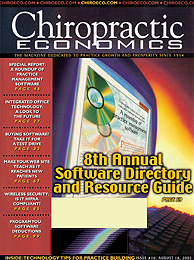|
  Aug. 2003—Purchasing software can be a daunting task. Feature sets, operating-system compatibility and a host of other factors make choosing the right program confusing at best. Aug. 2003—Purchasing software can be a daunting task. Feature sets, operating-system compatibility and a host of other factors make choosing the right program confusing at best.
According to a study conducted by Monica Smith, DC, PhD; Lynne Carber, BD; and Mark Doerrfield, DC and published by Palmer Research Institute, a large percentage of doctors of chiropractic use software for the business aspects of the practice, such as billing and patient scheduling, but very few have automated clinical functions.
So how do you make the leap into the technological age? Once you have made the decision to upgrade, the Palmer Research Institute recommends that you visit the various software companies online and don’t be afraid to call and ask questions. Ask for an on-site demonstration with you and your staff. Note how user-friendly both the software and support are.
If you are a new doctor just getting started, the Institute recommends considering software that has:
• An appointment book,
• SOAP/documentation capabilities,
• Word processing,
• Electronic claims,
• Insurance claims,
• Patient tracking and
• Automated notes.
If you are an established doctor who has been in practice for a while, in addition to the above criteria, look for software that will:
• Allow you to transfer files from your old system to the new,
• Integrate with other software programs that you are not upgrading,
• Speed up your workflow and
• Comply with all HIPAA regulations.
Make a list of all the things you would like your software to do before you make any phone calls or visit any Websites. Prioritize the list to know what features and functions are most important to you and your staff.
Ranking the features ahead of time will allow you to narrow the list of possible solutions up front, rather than waste your time researching solutions that will not perform the basic functions of your office.
Chiropractic Economics has gathered information on a number of the most popular software programs that are designed for chiropractic practices, and provided you with a brief synopsis of each. For an extended list, visit the Software Directory on page 59. It is our hope that you will use this article and the accompanying directory as a resource to begin your search.
|


